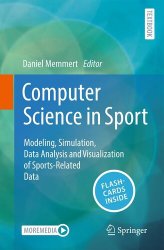Computer Science in Sport: Modeling, Simulation, Data Analysis and Visualization of Sports-Related Data
- Добавил: literator
- Дата: 8-03-2024, 17:58
- Комментариев: 0
 Название: Computer Science in Sport: Modeling, Simulation, Data Analysis and Visualization of Sports-Related Data
Название: Computer Science in Sport: Modeling, Simulation, Data Analysis and Visualization of Sports-Related DataАвтор: Daniel Memmert
Издательство: Springer
Год: 2024
Страниц: 247
Язык: английский
Формат: pdf (true), epub
Размер: 17.7 MB
In recent years, computer science in sport has grown extremely, mainly because more and more new data has become available. Computer Science tools in sports, whether used for opponent preparation, competition, or scientific analysis, have become indispensable across various levels of expertise nowadays. A completely new market has emerged through the utilization of these tools in the four major fields of application: clubs and associations, business, science, and the media. This market is progressively gaining importance within university research and educational activities.
This textbook aims to live up to the now broad diversity of Computer Science in sport by having more than 30 authors report from their special field and concisely summarise the latest findings. The book is divided into four main sections: data sets, modelling, simulation and data analysis. In addition to background information on programming languages and visualisation, the textbook is framed by history and an outlook.
Students with a connection to sports science are given a comprehensive insight into Computer Science in sport, supported by a didactically sophisticated concept that makes it easy to convey the learning content. Numerous questions for self-testing underpin the learning effect and ensure optimal exam preparation. For advanced students, the in-depth discussion of time series data mining, artificial neural networks, convolution kernels, transfer learning and random forests offers additional value.
The R programming language was developed with the aim of making data analysis as simple as possible. Historically, R originated as a free alternative to the S language. Today, R is the franca lingua for statistical analyses in the field of university research and has largely replaced other proprietary statistical packages. Another leap in the dissemination of R came with the release of RStudio (now Posit). RStudio is an integrated development environment based on R which simplifies the handling of various functionalities. RStudio is developed by RStudio PBC (public benefit corporation). The development environment has once again made access to R much easier for programming novices without, however, abandoning the core idea of interactive data analysis in combination with longer scripts or programs. Therefore, even with RStudio, data analysis using mouse-driven menus is not possible and users interact with R using commands, which is still the most efficient way of analyzing data. Today, R runs on all standard operating systems (Linux, Windows, macOS) as well as on numerous non-standard systems.
Python is a dynamic, object-oriented, high-level open-source programming language and one of the most popular languages for Data Science tasks. The large volume of data generated in sports require efficient and flexible analysis pipelines, spanning from large-scale data pre-processing (such as position and event data) to modelling by means of Machine Learning or Artificial Intelligence (AI). Python offers a wide range of functionalities through its various libraries, providing solutions for every processing step occurring in sports analytics. Among Data Scientists, Python enjoys great popularity as the programming language of choice owing to its features, which are discussed in the next section. Also for the various use cases in sports analytics, Python might have come out on top as a programming language. Python is highly popular in the community of data scientists in general and sports analysts in particular because it is a open-source, dynamic, object-oriented, high-level programming language, which provides highly flexible and up-to-date functionalities due to its available modules and libraries. With respect to the above-mentioned necessities, the following libraries are particularly valuable: Pandas provides functionalities for data import from different sources and illustrative presentation. NumPy enables efficient calculations, including numerous vector and matrix operations, whereas SciPy provides functions for calculus and time series analysis. As an extension to the rudimentary visualizations in Pandas, the package Matplotlib contains a variety of possibilities for data visualization. Finally, via Statsmodels one can employ “traditional” statistical models such as linear models and generalized linear models, while in Scikit-learn algorithms from Machine Learning can be implemented. Having all those functionalities available simultaneously along with the dynamic nature of Python, enabling interactive programming and therefore quick and flexible analyses, makes the language especially valuable for data analysis and processing tasks. The high level of abstraction furthermore makes learning the language from scratch easier.
Contents:
Скачать Computer Science in Sport: Modeling, Simulation, Data Analysis and Visualization of Sports-Related Data
[related-news] [/related-news]
Внимание
Уважаемый посетитель, Вы зашли на сайт как незарегистрированный пользователь.
Мы рекомендуем Вам зарегистрироваться либо войти на сайт под своим именем.
Уважаемый посетитель, Вы зашли на сайт как незарегистрированный пользователь.
Мы рекомендуем Вам зарегистрироваться либо войти на сайт под своим именем.

